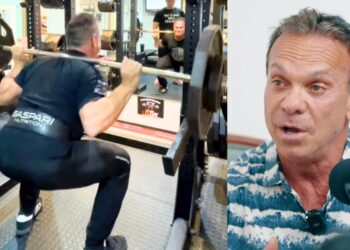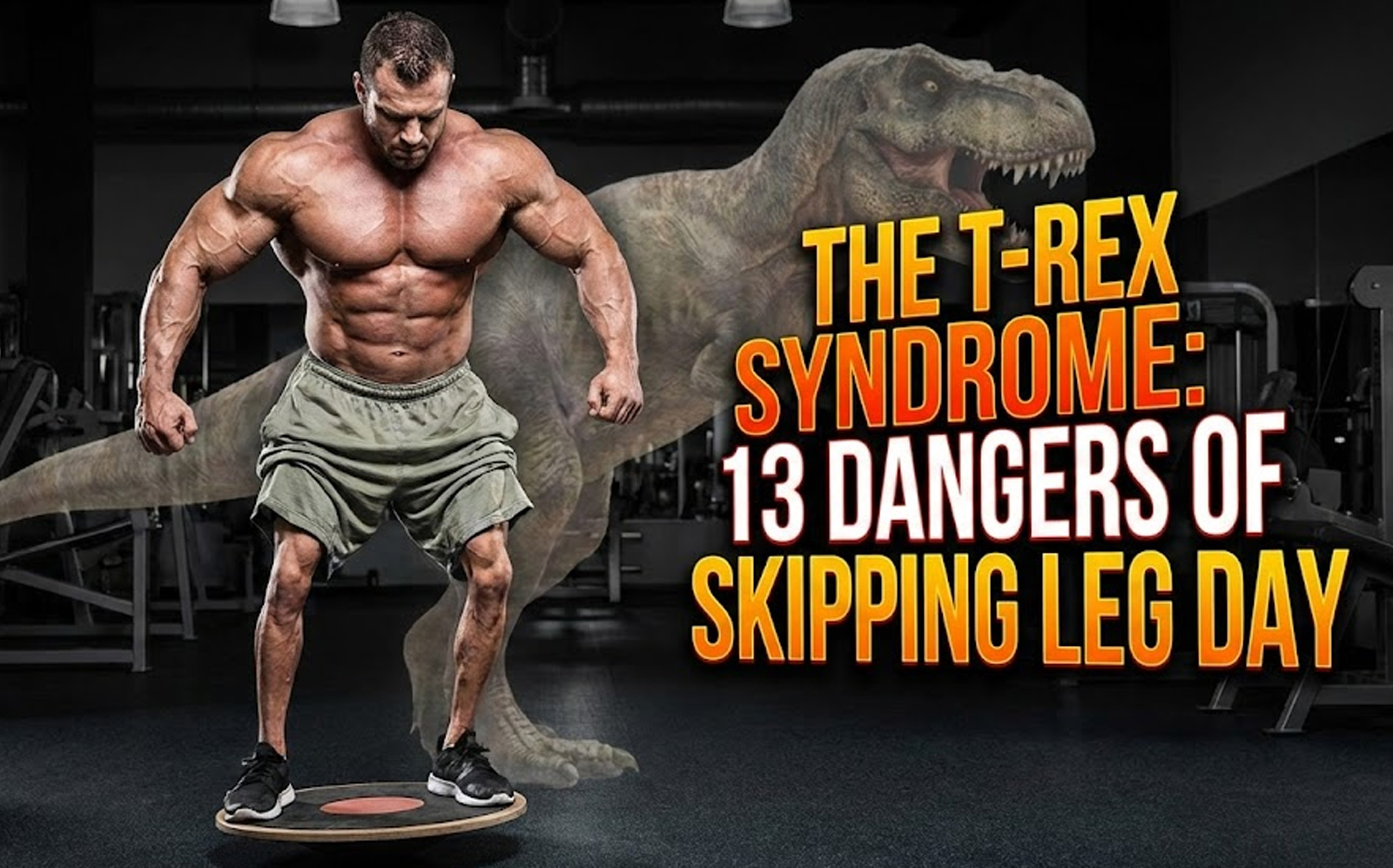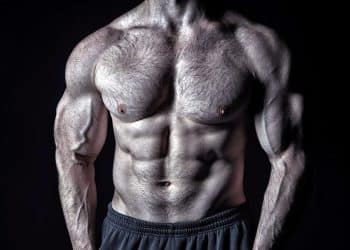Bodybuilding science has come a very long way in the last few decades. Scientists have studied and discovered what makes muscles grow, and that information has trickled down to bodybuilders, resulting in ever more complicated workouts and training methods.
While technical and informational advancements are usually helpful, it also means that a lot of lifters are getting drawn away from what really builds muscle and strength – hard work!
This workout is the opposite of all those science-driven training plans that are so complicated that you need to be a doctor in sports science to understand.
With no machines or fancy training methods, we’re going back to the old-school with this no-frills, freeweights-only bodybuilding workout!
Freeweight Workout – Overview
Because a freeweights-only workout has a real old-school bodybuilding vibe, it’s only right we use an old-school body-part split, training each major muscle once every seven days.
Your weekly workout split looks like this:
Level Up Your Fitness: Join our 💪 strong community in Fitness Volt Newsletter. Get daily inspiration, expert-backed workouts, nutrition tips, the latest in strength sports, and the support you need to reach your goals. Subscribe for free!
| Mon | Tue | Wed | Thu | Fri | Sat | Sun |
| Legs | Chest | Rest | Back | Shoulders | Arms | Rest |
Each workout involves several exercises per muscle group to a) provide the volume needed to trigger hypertrophy and b) hit your muscles from a range of angles.
You’ll also be training with a few different rep ranges to ensure that all muscle fibers are fully engaged. Lower reps with high weights are perfect for developing strength and muscle density, while lighter weights and higher reps will produce that all-important pump effect.
Of course, before you do any of these workouts, you must start with a warm-up to prepare your body for what you are about to do.
5-10 minutes of easy cardio followed by some dynamic mobility and flexibility should get the job done. Also, do 1-3 light sets of the first exercise to increase muscle activation and ensure you are “in the groove” and ready to train.
The workouts are as follows:
Freeweight-only workout #1 – Legs
| # | Exercise | Sets | Reps | Recovery |
| 1 | Back squat | 5 | 4-6 | 2-3 minutes |
| 2 | Romanian deadlift | 4 | 8-10 | 90 seconds |
| 3 | Walking lunge | 4 | 10-12 per leg | 60 seconds |
| 4 | Dumbbell leg curl | 3 | 12-15 | 60 seconds |
| 5 | Single-leg calf raise | 3 | 12-15 | 60 seconds |
| 6 | Tiptoe farmer’s walk | 3 | Max distance | 60 seconds |
Freeweight-only workout #2 – Chest
| # | Exercise | Sets | Reps | Recovery |
| 1 | Wide-grip bench press | 5 | 4-6 | 2-3 minutes |
| 2 | Incline dumbbell press | 4 | 8-10 | 90 seconds |
| 3 | Dumbbell fly | 3 | 10-12 | 60 seconds |
| 4 | Dumbbell squeeze press | 3 | 12-15 | 60 seconds |
| 5 | Push-up | 1 | 100 | N/A |
Freeweight-only workout #3 – Back
| # | Exercise | Sets | Reps | Recovery |
| 1 | Deadlift | 5 | 4-6 | 2-3 minutes |
| 2 | Weighted pull-up | 4 | 6-8 | 90 seconds |
| 3 | Single-arm row | 3 | 8-10 per arm | 60 seconds |
| 4 | Pendlay row | 3 | 10-12 | 60 seconds |
| 5 | Dumbbell shrug | 3 | 12-15 | 60 seconds |
Freeweight-only workout #4 – Shoulders
| # | Exercise | Sets | Reps | Recovery |
| 1 | Barbell push-press | 5 | 4-6 | 2-3 minutes |
| 2 | Arnold press | 4 | 6-8 | 90 seconds |
| 3 | Dumbbell side raise | 3 | 10-12 | 60 seconds |
| 4 | Reverse fly | 3 | 10-12 | 60 seconds |
| 5 | Upright row | 3 | 12-15 | 60 seconds |
Freeweight-only workout #5 – Arms
| # | Exercise | Sets | Reps | Recovery |
| 1 | Barbell curl | 3 | 6-8 | 90 seconds |
| 2 | Triceps dips | 3 | 6-8 | 90 seconds |
| 3 | Hammer curl | 3 | 10-12 | 60 seconds |
| 4 | Skull crusher | 3 | 10-12 | 60 seconds |
| 5 | Concentration curl | 3 | 12-15 per arm | 60 seconds |
| 6 | Dumbbell kickback | 3 | 12-15 per arm | 60 seconds |
Exercise Instructions
There are two ways to do any exercise: the right way and the wrong way. The right way is easy on your joints, puts plenty of tension on the target muscle, and produces the best results. The wrong way is usually less effective and more likely to cause injury. So, make sure you do each exercise in this workout the right way by following these instructions.
Freeweight-only workout #1 – Legs
This is arguably the most challenging training day of the week, which is why we’ve put it first. It’s your only leg workout, so give it maximum effort!
1. Back squat
The barbell back squat is arguably the most productive leg exercise you can do. Working your glutes, hamstrings, and quadriceps simultaneously, it really deserves its title of the king of exercises. Do squats in a power rack so you can train to failure in safety. If that’s not possible, make sure you stop each set with 1-2 reps left in the tank, so you don’t get trapped under a heavy bar.
Revise your back squat technique here.
2. Romanian deadlift
Romanian deadlifts are one of the best posterior chain exercises around. They target your glutes, hamstrings, and lower back, and provide your upper back with a decent workout, too. Make them as effective as possible by getting a good stretch in your hamstrings at the bottom of each rep. However, take care not to round your lower back as that can cause serious injury.
Learn how to do Romanian deadlifts correctly here.
3. Walking lunge
Some bodybuilders think that lunges are a fruitless exercise or that they should not be done with heavy weights. Neither of these views are true! Just ask Ronnie Coleman, who regularly did walking lunges with 100kg/220 lbs. on his back.
While you don’t have to go that heavy yourself, there is no reason not to use good-sized dumbbells or a hefty barbell for this exercise.
How to do it:
- Stand with your feet together, arms by your sides. Brace your core, pull your shoulders down and back, and look straight ahead.
- Take a large step forward, bend your legs, and lower your rearmost knee down to an inch above the floor.
- Push off your back leg and step forward into your next lunge. Alternate leading legs step by step.
- Continue for the prescribed number of reps or distance, e.g., 30 yards.
4. Dumbbell leg curl
Before leg curl machines were invented, this is how old-school bodybuilders isolated their hamstrings. It’s a slightly awkward exercise, but tomorrow’s muscle soreness will soon tell you just how effective this exercise is!
Read more about dumbbell leg curls here.
5. Single-leg calf raise
Don’t think that this exercise is in any way inferior to the calf raise machine. It’s not. In fact, working one leg at a time increases stabilizer and muscle fiber activation for an even better calf workout. So, grab a dumbbell and get to work!
Learn how to do single-leg calf raises here.
6. Tiptoe farmer’s walk
This unusual calf exercise used to be an old-school training staple. It’s so effective that it’s time to bring it back! All you need is a couple of heavy dumbbells and some space.
How to do it:
- Hold a heavy dumbbell in each hand using straps if you need to reinforce your grip.
- Rise up onto your tiptoes.
- Without lowering your heels, walk around your training area until your calves are pumped and burning.
- You could also do this exercise with a barbell across your upper back.
Related: Farmer’s Walk Guide: How-To, Muscles Worked, Variations, and Benefits
Freeweight-only workout #2 – Chest
Monday might be National Bench Press Day, but we’ve moved it to Tuesday for this program. Hopefully, you’ll have less competition for the bench press station because the rest of the bros used it yesterday!
1. Wide-grip bench press
The wide grip bench press is more chest-centric than the standard variation. Don’t take your hands out ultra-wide, as that can be hard on your shoulders. Instead, just move your hands about six inches outside of your regular bench press grip to maximize pec activation.
Do this exercise in a power rack or with a spotter on hand. If neither is possible, make sure you stop each set with 1-2 reps left in the tank, so you don’t get trapped under a heavy bar.
Read more about this exercise here.
2. Incline dumbbell press
Incline dumbbell presses work your upper chest. Set the bench to between 30-45 degrees to maximize pec engagement without putting too much stress on your anterior deltoids. Focus on getting a good stretch between reps to make this exercise as effective as possible.
Learn how to do dumbbell incline presses here.
3. Dumbbell fly
Before pec decks and cable crossover machines were invented, dumbbell flies were how old-school bodybuilders isolated their chests.
This is NOT an exercise for going really heavy. Instead, use light to moderate weights and chase the pump. You can do dumbbell flies on a flat or incline bench as preferred. Inclines hit your upper chest more.
Read more about dumbbell flies here.
4. Dumbbell squeeze press
The dumbbell squeeze press, also known as the narrow grip dumbbell press, is an unusual yet very effective chest exercise. To do it, you must press the dumbbells inward, which increases pectoral muscle engagement. Don’t use too much weight for this exercise. Instead, focus more on pushing the weights together.
Learn how to do this exercise here.
5. Push-up
The last exercise in your chest workout is push-ups. Okay, so it’s NOT a freeweight exercise, but you should have no problem doing it as you don’t need any machines. Just crank out 100 push-upsin as few sets as you can. Rest when you need to, but don’t quit until you’ve done all 100 reps.
Revise your push-up technique here.
Freeweight-only workout #3 – Back
A lot of bodybuilders are a little too focused on the muscles they can see in the mirror. Let’s fix that problem with a big old freeweight back workout!
1. Deadlift
While some people like to do deadlifts on leg day, they’re also a great back-builder. You’re not a powerlifter, so don’t get too hung up on trying to lift the heaviest possible weights. Instead, focus more on your mind-muscle connection and engage your lats and other back muscles as much as you can.
Level Up Your Fitness: Join our 💪 strong community in Fitness Volt Newsletter. Get daily inspiration, expert-backed workouts, nutrition tips, the latest in strength sports, and the support you need to reach your goals. Subscribe for free!
Learn how to master the deadlift here.
2. Weighted pull-up
With no lat pulldowns allowed, pull-ups are the next best exercise for building a bigger, wider back. Strap on some weight to make them more challenging. Just make sure you pull your chin all the way up and over the bar, and then extend your arms fully between reps. And no kicking your legs – you’re not training for CrossFit. Make sure your arms and lats are doing 100-percent of the work.
Read more about pull-ups here.
3. Single-arm row
The single-arm row is a great back exercise that’s also easy on your lumbar spine. With one arm free, you can use it to support your lower back and focus on working each side of your lats equally. Keep your upper arm close to your side and concentrate on driving your elbow back and up to the ceiling to maximize lat engagement.
Learn how to do single-arm dumbbell rows here.
4. Pendlay row
Pendlay rows are named after American Olympic weightlifting and powerlifting coach Glen Pendlay. Also known as dead stop rows, this exercise is a lot like regular bent-over rows, but every rep starts with the weight resting on the floor. This takes pressure off your lower back and relieves your grip, so you should be able to train with heavier weights and do more reps without overloading your lumbar spine.
Learn how to do Pendlay rows here.
5. Dumbbell shrug
Dumbbell shrugs target your upper traps to give that famous “yoked” look. Dumbbells are a better choice than a barbell because they mean you can keep your arms by your sides and pull your shoulders straight up, maximizing upper trap engagement. Do NOT roll your shoulders backward, which adds nothing to the exercise and could cause joint injuries.
Read more about dumbbell shrugs here.
Freeweight-only workout #4 – Shoulders
English playwright William Shakespeare once wrote that “clothes make the man.” Not true – it’s your shoulders! Big, broad shoulders give your body its V-taper, and there is nothing more manly than cannonball delts paired with a narrow, lean waist.
1. Barbell push-press
Barbell push-presses allow you to lift heavier weights than usual. That’s good for building bigger, stronger delts. Lower the weight slowly to maximize the eccentric contraction to trigger hypertrophy while building impressive levels of strength.
Learn how to perform this potent delt-builder here.
2. Arnold press
Named after bodybuilding legend Arnold Schwarzenegger, this is one of the few exercises to hit all three deltoids simultaneously. Use light to moderate weights and focus on a smooth, controlled motion to make the Arnold press as effective as possible. Do this shoulder exercise seated or standing as preferred.
Read more about this famous exercise here.
3. Dumbbell side raise
Dumbbell side raises target your medial or side deltoids. This deltoid head is responsible for the width of your shoulders. If you want a more impressive upper body that’s both deep AND wide, this exercise is a must.
However, because of the long levers involved, you won’t need to use a lot of weight to get a great delt workout. You can do side raises standing or seated as you prefer.
Find out how to do dumbbell side raises here.
4. Reverse fly
Most bodybuilders have underdeveloped posterior or rear deltoids. That’s because this deltoid head is not involved in most upper body exercises.
Training it in isolation with reverse or bent-over flies is one of the best ways to ensure your rear delts don’t lag behind the rest of your shoulder muscles. It’s also good for your posture and general shoulder health.
Learn how to do this essential shoulder exercise here.
5. Upright row
Upright rows are one of the few pulling exercises that also work your shoulders. The movement is actually a lot like a side lateral raise done with bent arms. Pull the bar up to your mid-chest to work your deltoids without straining your shoulder joints. This exercise can be done using a barbell or dumbbells as required.
Find out how to do upright rows here.
Freeweight-only workout #5 – Arms
There isn’t a bodybuilder alive who doesn’t want bigger, more muscular arms, and this is the workout to build them!
1. Barbell curl
The barbell curl is a classic exercise for a reason – it works! Use moderate to heavy weights and really squeeze your arms at the top of each rep for maximum effect. However, do your best not to swing the weight up as that just takes tension off your biceps.
Read more about barbell curls here.
2. Triceps dips
There are two ways to do parallel bar dips – by leaning forward and extending your legs out behind you to target your chest or with a more upright torso to challenge your triceps. This is your arm workout, so make sure you do the latter!
Learn how to do dips for your triceps here.
3. Hammer curl
Hammer curls are so-called because, when you do them, it looks like you are knocking in a nail with a hammer. This exercise not only works your biceps but your brachioradialis and brachialis too. Developing all these muscles together will increase both forearm and upper arm size.
Learn how to do hammer curls here.
4. Skull crusher
This aptly named exercise involves lowering a barbell to your forehead. Bring the weight down slowly, so you don’t hit yourself in the head! So do skull crushers with a spotter or, if that’s not possible, use dumbbells, so you miss your head entirely. The dumbbell variation also allows for a slightly bigger range of motion, which may be better for hypertrophy.
Find out how to do this exercise here.
5. Concentration curl
In studies, concentration curls have been revealed as one of the best exercises for maximal muscle engagement (1). You won’t be able to lift heavy weights with this exercise. Still, with no chance of cheating and no help from your anterior deltoid, it does a fantastic job at isolating your biceps.
Learn more about concentration curls here.
6. Dumbbell kickback
Dumbbell kickbacks are one of those exercises that looks easy but actually isn’t. It’s basically the triceps equivalent of concentration curls and is a very effective way to isolate your triceps.
However, lack of leverage means you won’t be able to lift heavy weights. Instead, focus on keeping your upper arm parallel to the floor and extending your elbow fully at the top of each rep.
Find out how to do dumbbell kickbacks here.
Wrapping Up
Some bodybuilding workouts are so complex that you need a Ph.D. to understand them and a state-of-the-art gym to do them! Things like tempo, time under tension, accommodating resistance, rotary cams, movement velocity, occlusion, and all that other science does have a place in bodybuilding. But, sometimes, it’s nice to disengage your brain and just work hard without worrying about all that complicated stuff.
This workout is designed to be the antithesis of all those science-driven bodybuilding workouts. It’s about as old-school as you can get and puts the work back into workout.
So, whether you’re limited to training with freeweights in your garage gym or just want to go back to the roots of bodybuilding, this no-frills workout will help you build muscle without any brain strain.
Just lift, eat, sleep, and repeat!
References:
1- American Council on Exercise (ACE): ACE Study Reveals Best Biceps Exercises www.acefitness.org
Featured image: @cbum on Instagram








